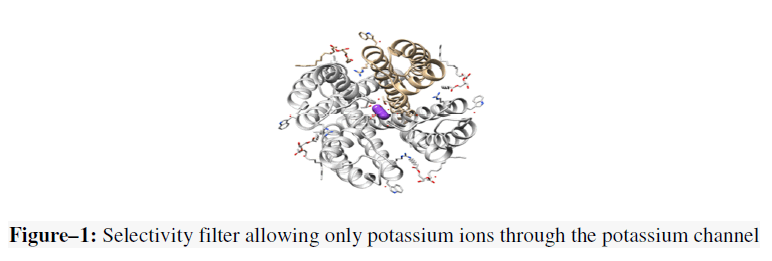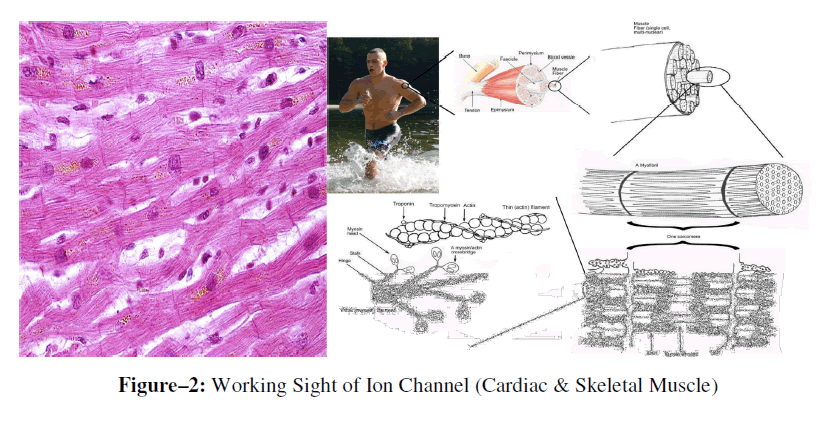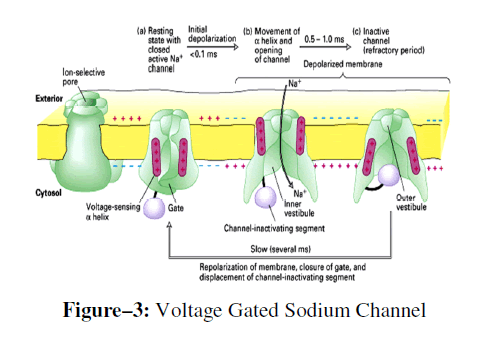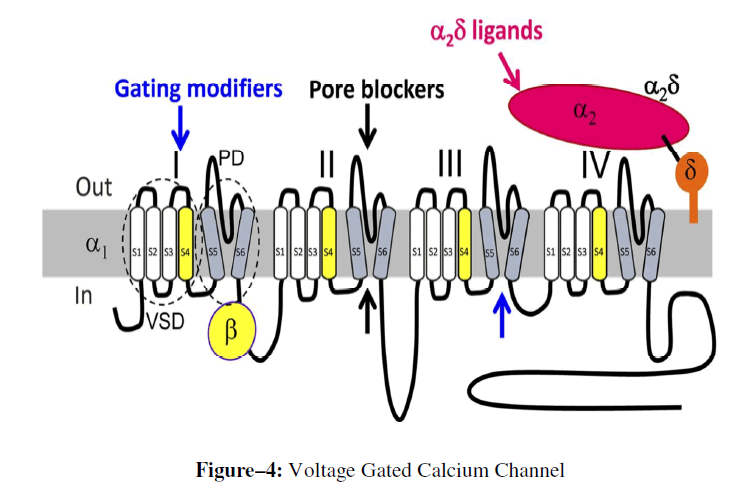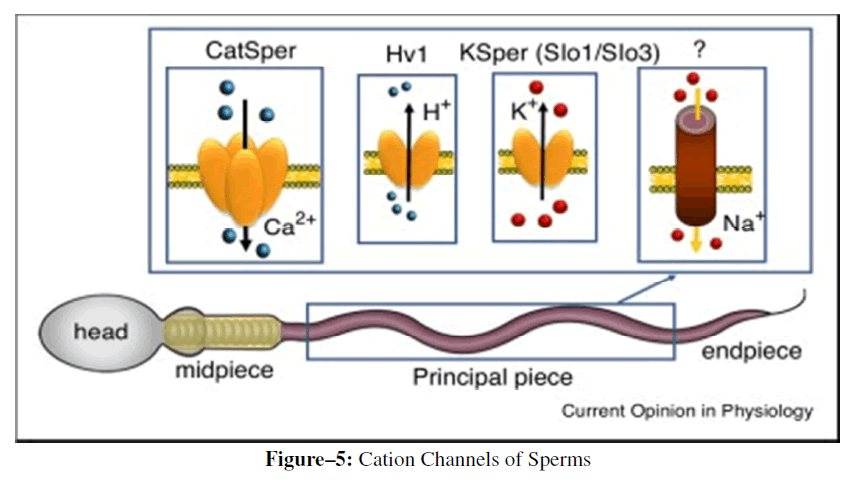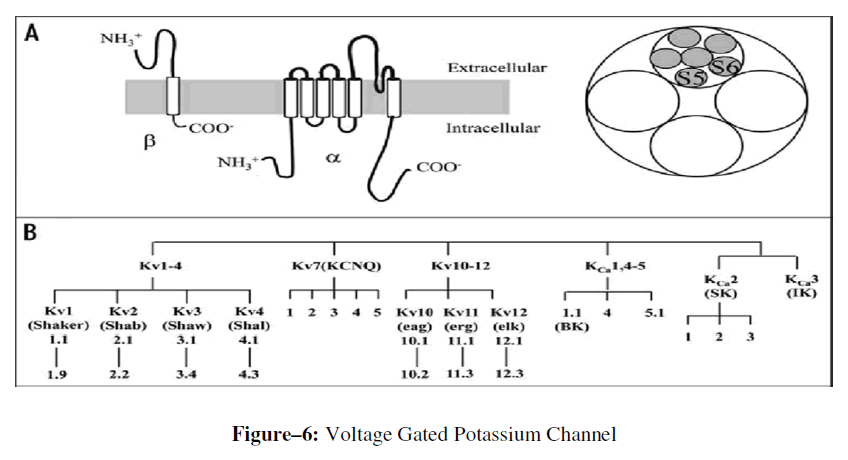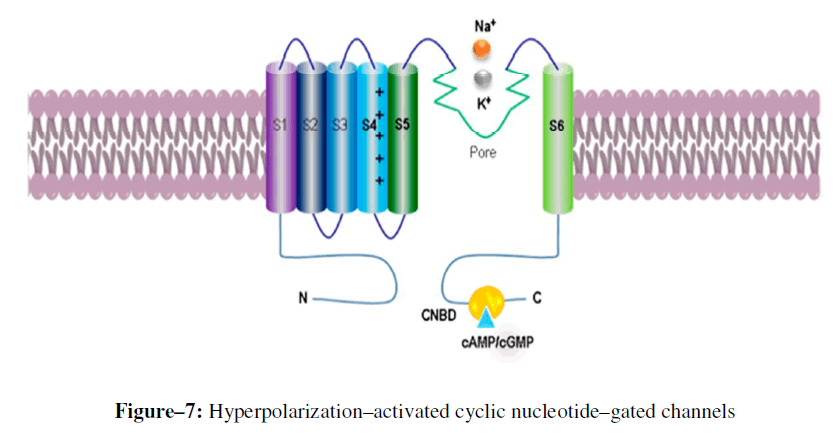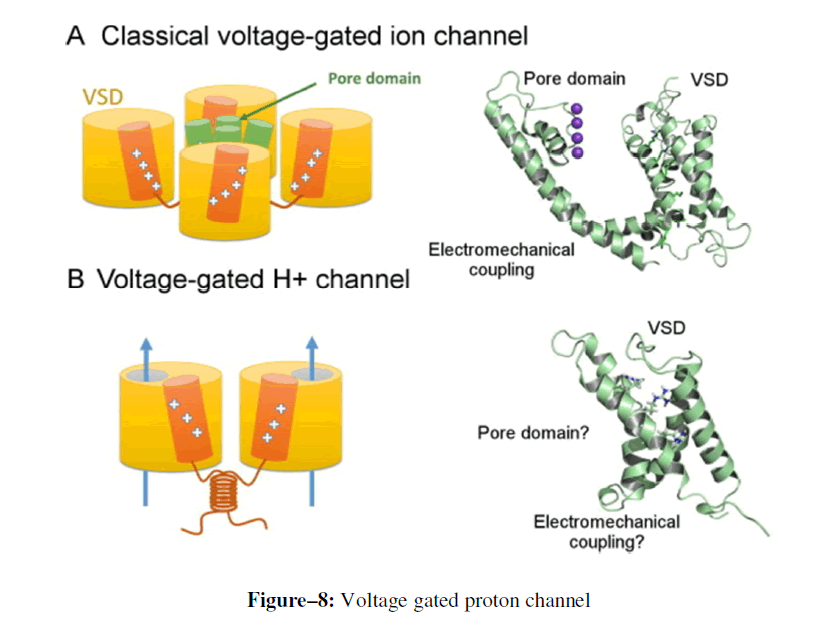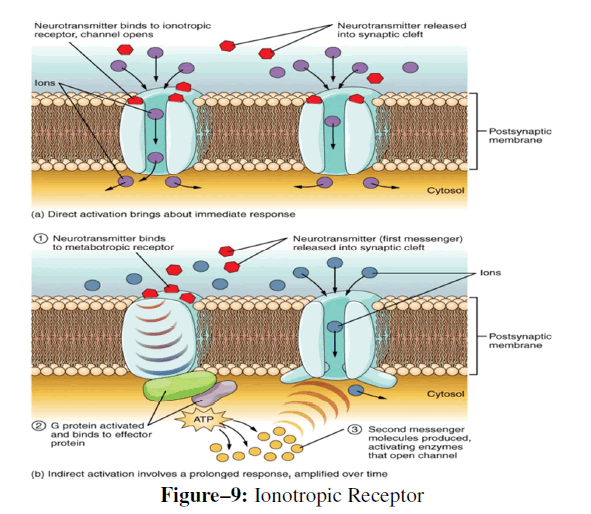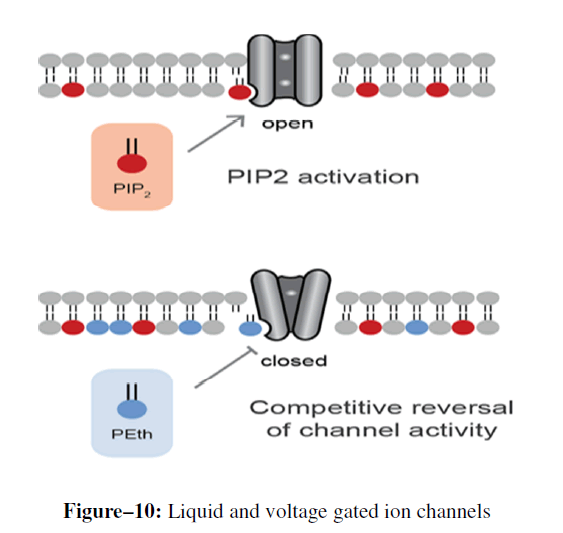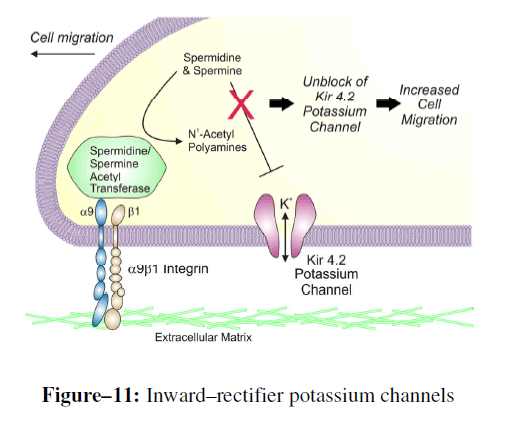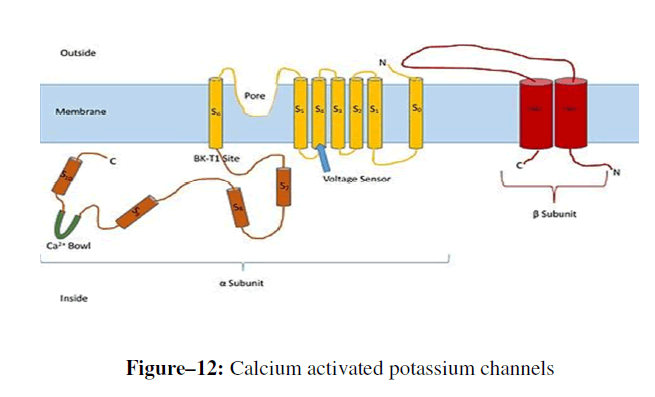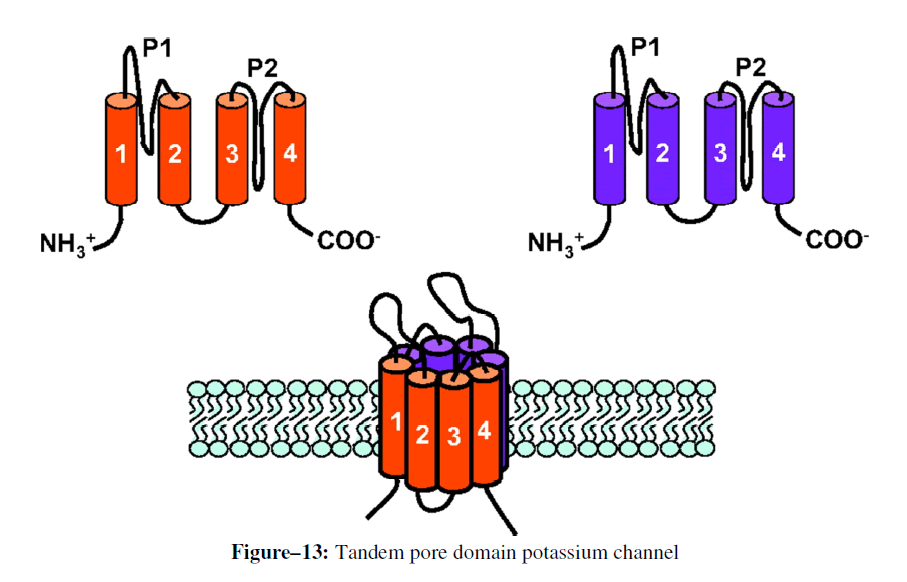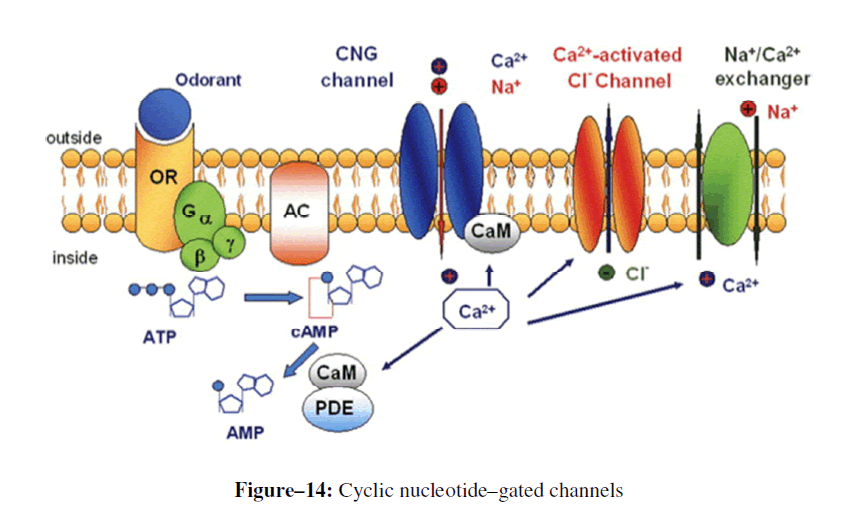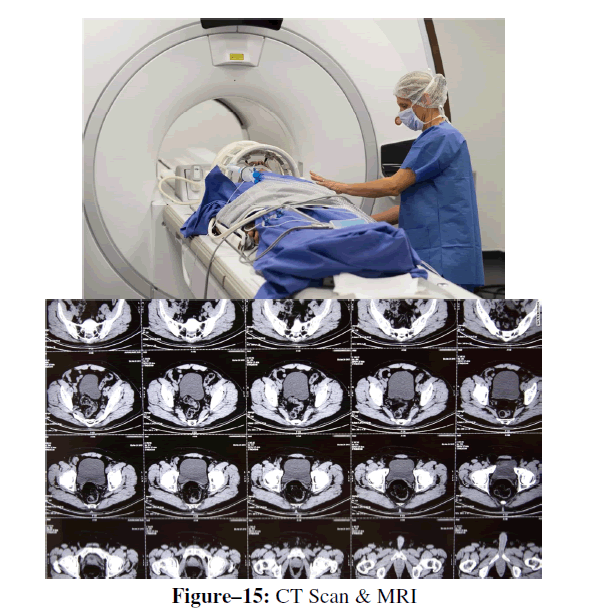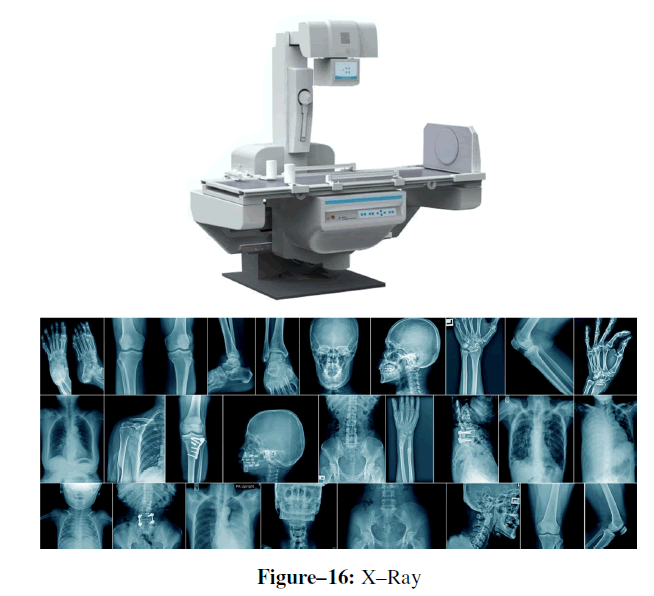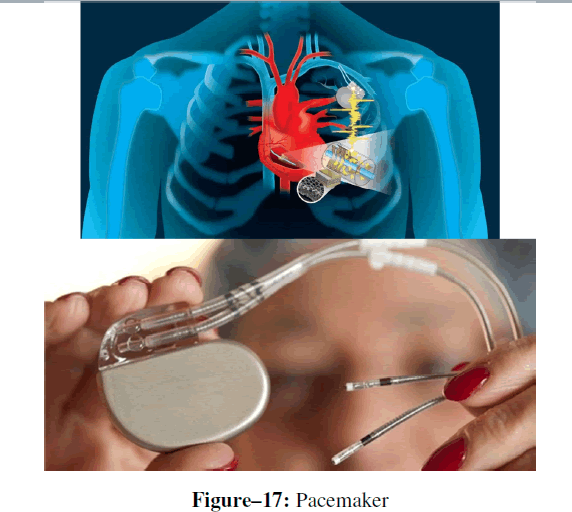Keywords
ATP, RT–PCR, Biophysics, Ion channel, Action potential, XRD
Introduction
There are two distinctive features of ion channels that
differentiate them from other types of ion transporter
proteins:
1.The rate of ion transport through the channel is very high
(often 106 ions per second or greater).
2.Ions pass through channels down their electrochemical
gradient, which is a function of ion concentration and
membrane potential, "downhill", without the input (or help)
of metabolic energy (e.g. ATP, co–transport mechanisms,
or active transport mechanisms).[1]
Ion channels are located within the membrane of all excitable cells, and of many intracellular organelles. They
are often described as narrow, water–filled tunnels that
allow only ions of a certain size and/or charge to pass
through. This characteristic is called selective permeability.
The archetypal channel pore is just one or two atoms wide
at its narrowest point and is selective for specific species of
ion, such as sodium or potassium. However, some channels
may be permeable to the passage of more than one type of
ion, typically sharing a common charge: positive (cations)
or negative (anions). Ions often move through the segments
of the channel pore in single file nearly as quickly as the ions
move through free solution. In many ion channels, passage
through the pore is governed by a "gate", which may be
opened or closed in response to chemical or electrical signals, temperature, or mechanical force.[2]
Ion channels are integral membrane proteins, typically
formed as assemblies of several individual proteins. Such
"multi–subunit" assemblies usually involve a circular
arrangement of identical or homologous proteins closely
packed around a water–filled pore through the plane of
the membrane or lipid bilayer. For most voltage–gated
ion channels, the pore–forming subunit(s) are called the α
subunit, while the auxiliary subunits are denoted β, γ, and
so on.(Figure 1)
Figure 1: Selectivity filter allowing only potassium ions through the potassium channel
Biologicalrole
Because channels underlie the nerve impulse and because
"transmitter–activated" channels mediate conduction across
the synapses, channels are especially prominent components
of the nervous system. Indeed, numerous toxins that organisms
have evolved for shutting down the nervous systems of
predators and prey (e.g., the venoms produced by spiders,
scorpions, snakes, fish, bees, sea snails, and others) work
by modulating ion channel conductance and/or kinetics. In
addition, ion channels are key components in a wide variety
of biological processes that involve rapid changes in cells,
such as cardiac, skeletal, and smooth muscle contraction,
epithelial transport of nutrients and ions, T–cell activation
and pancreatic beta–cell insulin release. In the search for
new drugs, ion channels are a frequent target.[3] (Figure 2)
Figure 2: Working Sight of Ion Channel (Cardiac & Skeletal Muscle)
Diversity
There are over 300 types of ion channels just in the cells of
the inner ear. Ion channels may be classified by the nature of
their gating, the species of ions passing through those gates,
the number of gates (pores) and localization of proteins.
Further heterogeneity of ion channels arises when channels
with different constitutive subunits give rise to a specific
kind of current. Absence or mutation of one or more of the
contributing types of channel subunits can result in loss of
function and, potentially, underlie neurologic diseases.[4]
Classification by gating
Ion channels may be classified by gating, i.e. what opens
and closes the channels. For example, voltage–gated ion
channels open or close depending on the voltage gradient
across the plasma membrane, while ligand–gated ion
channels open or close depending on binding of ligands to
the channel.[5] (Figure 3)
Figure 3: Voltage Gated Sodium Channel
Voltage–gated sodium channels: This family contains
at least 9 members and is largely responsible for action
potential creation and propagation. The pore–forming
α subunits are very large (up to 4,000 amino acids) and
consist of four homologous repeat domains (I–IV) each
comprising six transmembrane segments (S1–S6) for a total
of 24 transmembrane segments. The members of this family
also assembled with auxiliary β subunits, each spanning the membrane once. Both α and β subunits are extensively
glycosylated.
Voltage–gated calcium channels: This family contains 10
members, though these are knownto coassemble with α2δ,
β, and γ subunits. These channels play an important role in
both linking muscle excitation with contraction as well as
neuronal excitation with transmitter release. The α subunits
have an overall structural resemblance to those of the
sodium channels and are equally large.[6] (Figure 4)
Figure 4: Voltage Gated Calcium Channel
Cation channels of sperm: This small family of channels,
normally referred to as Catsper channels, is related to
the two–pore channels and distantly related to TRP
channels.(Figure 5)
Figure 5: Cation Channels of Sperms
Voltage–gated potassium channels (KV):This family
contains almost 40 members, which are further divided into
12 subfamilies. These channels are known mainly for their
role in repolarizing the cell membrane following action
potentials. The α subunits have six transmembrane
segments, homologous to a single domain of the sodium
channels. Correspondingly, they assemble as tetramers to
produce a functioning channel.[7] (Figure 6)
Figure 6: Voltage Gated Potassium Channel
Some transient receptor potential channels: This group of
channels, normally referred to simply as TRP channels,
is named after their role in Drosophila phototransduction.
This family, containing at least 28 members, is incredibly
diverse in its method of activation. Some TRP channels
seem to be constitutively open, while others are gated by
voltage, intracellular Ca2+, pH, redox state, osmolarity, and
mechanical stretch. These channels also vary according to
the ion(s) they pass, some being selective for Ca2+ while
others are less selective, acting as cation channels. This
family is subdivided into 6 subfamilies based on homology:
classical (TRPC), vanilloid receptors (TRPV), melastatin
(TRPM), polycystins (TRPP), mucolipins (TRPML), and
ankyrin transmembrane protein 1 (TRPA).
Hyperpolarization–activated cyclic nucleotide–
gated channels: The opening of these channels is due
to hyperpolarization rather than the depolarization required
for other cyclic nucleotide–gated channels.These channels
are also sensitive to the cyclic nucleotides cAMP and cGMP,
which alter the voltage sensitivity of the channel's opening.
These channels are permeable to the monovalent cations
K+ and Na+. There are 4 members of this family, all of
which form tetramers of six–transmembrane α subunits. As
these channels open under hyperpolarizing conditions, they
function as pacemaking channels in the heart, particularly
the SA node.[8] (Figure 7)
Figure 7: Hyperpolarization–activated cyclic nucleotide–gated channels
Voltage–gated proton channels: Voltage–gated proton
channels open with depolarization, but in a strongly pH–
sensitive manner. The result is that these channels open
only when the electrochemical gradient is outward, such that their opening will only allow protons to leave cells.
Their function thus appears to be acid extrusion from
cells. Another important function occurs in phagocytes
(e.g. eosinophils, neutrophils, macrophages) during the
"respiratory burst." When bacteria or other microbes
are engulfed by phagocytes, the enzyme NADPH
oxidase assembles in the membrane and begins to
produce reactive oxygen species (ROS) that help kill
bacteria. NADPH oxidase is electrogenic, moving electrons
across the membrane, and proton channels open to allow
proton flux to balance the electron movement electrically.
[9] (Figure 8)
Figure 8: Voltage gated proton channel
Ligand–gated (neurotransmitter): Also known as ionotropic
receptors, this group of channels open in response to specific
ligand molecules binding to the extracellular domain of the
receptor protein. Ligand binding causes a conformational
change in the structure of the channel protein that ultimately
leads to the opening of the channel gate and subsequent
ion flux across the plasma membrane. Examples of
such channels include the cation–permeable "nicotinic"
Acetylcholine receptor, ionotropic glutamate–gated
receptors, acid sensing ion channels (ASICs), ATP–gated
P2X receptors, and the anion–permeable γ–aminobutyric
acid–gated GABAA receptor.
Ion channels activated by second messengers may also
be categorized in this group, although ligands and second
messengers are otherwise distinguished from each other.
[10] (Figure 9)
Figure 9: Ionotropic Receptor
Lipid–gated: This group of channels opens in response
to specific lipid molecules binding to the channel's
transmembrane domain typically near the inner leaflet
of the plasma membrane. Phosphatidylinositol 4,5–
bisphosphate (PIP2) and phosphatidic acid (PA) are the
best–characterized lipids to gate these channels. Many of
the leak potassium channels are gated by lipids including
the inward–rectifier potassium channels and two pore
domain potassium channels TREK–1 and TRAAK. KCNQ
potassium channel family are gated by PIP2. The voltage
activated potassium channel (Kv) is regulated by PA. Its
midpoint of activation shifts +50 mV upon PA hydrolysis,
near resting membrane potentials. This suggests Kv could
be opened by lipid hydrolysis independent of voltage and
may qualify this channel as dual lipid and voltage gated
channel.[11] (Figure 10)
Figure 10: Liquid and voltage gated ion channels
Other gating
Gating also includes activation and inactivation by second
messengers from the inside of the cell membrane – rather
than from outside the cell, as in the case for ligands.
Some potassium channels
Inward–rectifier potassium channels: These channels
allow potassium ions to flow into the cell in an "inwardly rectifying" manner: potassium flows more efficiently
into than out of the cell. This family is composed of 15
official and 1 unofficial member and is further subdivided
into 7 subfamilies based on homology. These channels
are affected by intracellular ATP, PIP2, and G–protein βγ
subunits. They are involved in important physiological
processes such as pacemaker activity in the heart, insulin
release, and potassium uptake in glial cells. They contain
only two transmembrane segments, corresponding to the
core pore–forming segments of the KV and KCa channels.
Their α subunits form tetramers.[12] (Figure 11)
Figure 11: Inward–rectifier potassium channels
Calcium–activated potassium channels: This family of
channels is activated by intracellular Ca2+ and contains 8
members.(Figure 12)
Figure 12: Calcium activated potassium channels
Tandem pore domain potassium channel: This family of
15 members form what are known as leak channels, and
they display Goldman–Hodgkin–Katz (open) rectification.
Contrary to their common name of 'Two–pore–domain
potassium channels', these channels have only one pore but
two pore domains per subunit.
Two–pore channels include ligand–gated and voltage–
gated cation channels, so–named because they contain two
pore–forming subunits. As their name suggests, they have
two pores. Light–gated channels like channel rhodopsin are
directly opened by photons.[13]
Mechanosensitive ion channels open under the influence of
stretch, pressure, shear, and displacement.(Figure 13)
Figure 13: Tandem pore domain potassium channel
Cyclic nucleotide–gated channels: This superfamily of
channels contains two families: the cyclic nucleotide–
gated (CNG) channels and the hyperpolarization–activated,
cyclic nucleotide–gated (HCN) channels. This grouping is
functional rather than evolutionary
Cyclic nucleotide–gated channels: This family of
channels is characterized by activation by either
intracellular cAMP or cGMP. These channels are primarily
permeable to monovalent cations such as K+ and Na+. They
are also permeable to Ca2+, though it acts to close them.
There are 6 members of this family, which is divided
into 2 subfamilies. Hyperpolarization–activated cyclic
nucleotide–gated channels.(Figure 14)
Figure 14: Cyclic nucleotide–gated channels
Temperature–gated channels: Members of the transient
receptor potential ion channel superfamily, such
as TRPV1 or TRPM8, are opened either by hot or cold
temperatures.
Classification by type of ions
Chloride channels: This superfamily of channels consists
of approximately 13 members. They include ClCs, CLICs,
Bestrophins and CFTRs. These channels are non–selective
for small anions; however chloride is the most abundant
anion, and hence they are known as chloride channels.
Potassium channels
• Voltage–gated potassium channels e.g., Kvs, Kirs etc.
• Calcium–activated potassium channels e.g., BKCa or
MaxiK, SK, etc.
• Inward–rectifier potassium channels
• Two–pore–domain potassium channels: This
family of 15 members form what is known as leak
channels, and they display Goldman–Hodgkin–
Katz (open) rectification.
• Sodium channels: Voltage–gated sodium
channels (NaVs)
• Epithelial sodium channels (ENaCs)
• Calcium channels (CaVs)
• Proton channels
• Voltage–gated proton channels
• Non–selective cation channels: These non–selectively
allow many types of cations, mainly Na+, K+ and Ca2+,
through the channel.
• Most transient receptor potential channels
Classification by cellular localization
Ion channels are also classified according to their
subcellular localization. The plasma membrane accounts
for around 2% of the total membrane in the cell, whereas
intracellular organelles contain 98% of the cell's membrane.
The major intracellular compartments are endoplasmic
reticulum, Golgi apparatus, and mitochondria. On the basis
of localization, ion channels are classified as:
Plasma membrane channels: Examples: Voltage–gated
potassium channels (Kv), Sodium channels (Nav), Calcium
channels (Cav) and Chloride channels (ClC). Intracellular
channels, which are further classified into different
organelles.
Endoplasmic reticulum channels: RyR, SERCA, ORAi Mitochondrial channels: mPTP, KATP, BK, IK, CLIC5,
Kv7.4 at the inner membrane and VDAC and CLIC4 as
outer membrane channels.
Other classifications
Some ion channels are classified by the duration of their
response to stimuli:
Transient receptor potential channels: This group of
channels, normally referred to simply as TRP channels, is
named after their role in Drosophila visual phototransduction.
This family, containing at least 28 members, is diverse
in its mechanisms of activation. Some TRP channels
remain constitutively open, while others are gated
by voltage, intracellular Ca2+, pH, redox state, osmolarity, and mechanical stretch. These channels also vary according
to the ion(s) they pass, some being selective for Ca2+ while
others are less selective cation channels. This family is
subdivided into 6 subfamilies based on homology: canonical
TRP (TRPC), vanilloid receptors (TRPV), melastatin
(TRPM), polycystins (TRPP), mucolipins (TRPML), and
ankyrin transmembrane protein 1 (TRPA).[14]
Detailed structure
Channels differ with respect to the ion they let pass (for
example, Na+, K+, Cl−), the ways in which they may be
regulated, the number of subunits of which they are composed
and other aspects of structure. Channels belonging to the
largest class, which includes the voltage–gated channels
that underlie the nerve impulse, consists of four subunits
with six transmembrane helices each. On activation, these
helices move about and open the pore. Two of these six
helices are separated by a loop that lines the pore and is
the primary determinant of ion selectivity and conductance
in this channel class and some others. The existence and
mechanism for ion selectivity was first postulated in the
late 1960s by Bertil Hille and Clay Armstrong. The idea
of the ionic selectivity for potassium channels was that the
carbonyl oxygens of the protein backbones of the "selectivity
filter" (named by Bertil Hille) could efficiently replace the
water molecules that normally shield potassium ions, but
that sodium ions were smaller and cannot be completely
dehydrated to allow such shielding, and therefore could
not pass through. This mechanism was finally confirmed
when the first structure of an ion channel was elucidated.
A bacterial potassium channel KcsA, consisting of just
the selectivity filter, "P" loop and two transmembrane
helices was used as a model to study the permeability
and the selectivity of ion channels in the Mackinnon lab.
The determination of the molecular structure of KcsA
by Roderick MacKinnon using X–ray crystallography won
a share of the 2003 Nobel Prize in Chemistry.
Because of their small size and the difficulty of crystallizing
integral membrane proteins for X–ray analysis, it is only
very recently that scientists have been able to directly
examine what channels "look like." Particularly in cases
where the crystallography required removing channels from
their membranes with detergent, many researchers regard
images that have been obtained as tentative. An example
is the long–awaited crystal structure of a voltage–gated
potassium channel, which was reported in May 2003. One
inevitable ambiguity about these structures relates to the
strong evidence that channels change conformation as they
operate (they open and close, for example), such that the
structure in the crystal could represent any one of these
operational states. Most of what researchers have deduced
about channel operation so far they have established
through electrophysiology, biochemistry, gene sequence
comparison and mutagenesis.
Channels can have single (CLICs) to multiple transmembrane
(K channels, P2X receptors, Na channels) domains which
span plasma membrane to form pores. Pore can determine
the selectivity of the channel. Gate can be formed either
inside or outside the pore region.[15]
Pharmacology
Chemical substances can modulate the activity of ion
channels, for example by blocking or activating them.
Ion channel blockers
A variety of ion channel blockers (inorganic and organic
molecules) can modulate ion channel activity and
conductance. Some commonly used blockers include:
1. Tetrodotoxin (TTX), used by puffer fish and some types
of newts for defence. It blocks sodium channels.
2. Saxitoxin is produced by a dinoflagellate also known
as "red tide". It blocks voltage–dependent sodium
channels.
3. Conotoxin is used by cone snails to hunt prey.
4. Lidocaine and Novocaine belong to a class of local
anesthetics which block sodium ion channels.
5. Dendrotoxin is produced by mamba snakes, and blocks
potassium channels.
6. Iberiotoxin is produced by the Buthus tamulus (Eastern
Indian scorpion) and blocks potassium channels.
7. Heteropodatoxin is produced by Heteropoda
venatoria (brown huntsman spider or laya) and blocks
potassium channels.
Ion channel activators
Several compounds are known to promote the opening or
activation of specific ion channels. These are classified by
the channel on which they act:
1. Calcium channel openers, such as Bay K8644
2. Chloride channel openers, such as phenanthroline
3. Potassium channel openers, such as minoxidil
4. Sodium channel openers, such as DDT
Diseases
There are a number of disorders which disrupt normal
functioning of ion channels and have disastrous consequences
for the organism. Genetic and autoimmune disorders of ion
channels and their modifiers are known as channelopathies.
Shaker gene mutations cause a defect in the voltage
gated ion channels, slowing down the repolarization of
the cell. Equine hyperkalaemic periodic paralysis as well
as human hyperkalaemic periodic paralysis (HyperPP) are
caused by a defect in voltage–dependent sodium channels.
Paramyotonia congenita (PC) and potassium–aggravated myotonias (PAM). Generalized epilepsy with febrile
seizures plus (GEFS+). Episodic ataxia (EA), characterized
by sporadic bouts of severe discoordination with or
without myokymia, and can be provoked by stress, startle,
or heavy exertion such as exercise. Familial hemiplegic
migraine (FHM). Spinocerebellar ataxia type 13. Long
QT syndrome is a ventricular arrhythmia syndrome caused
by mutations in one or more of presently ten different genes,
most of which are potassium channels and all of which
affect cardiac repolarization. Brugada syndrome is another
ventricular arrhythmia caused by voltage–gated sodium
channel gene mutations. Polymicrogyria is a developmental
brain malformation caused by voltage–gated sodium
channel and NMDA receptor gene mutations. Cystic
fibrosis is caused by mutations in the CFTR gene, which
is a chloride channel. Mucolipidosis type IV is caused by
mutations in the gene encoding the TRPML1 channel.
Mutations in and overexpression of ion channels are
important events in cancer cells. In Glioblastoma
multiforme, upregulation of gBK potassium channels
and ClC–3 chloride channels enable glioblastoma cells to
migrate within the brain, which may lead to the diffuse
growth patterns of these tumors.[16] (Figure 15)
Radiopharmaceuticals are a special class of drugs. They
include diagnostic agents, such as molecular imaging
probes, contrast agents or tracers, as well as agents that treat
diseases, called radio therapeutics. A radiopharmaceutical
contains a radioactive isotope that emits energy, which
can be detected or used to provide an image (diagnostic
agent) or is directly therapeutic within a diseased tissue.
Millions of patients receive radiopharmaceuticals annually
for a wide variety of medical procedures ranging from the
assessment of cardiac function to staging and treatment of
cancer. Diagnostic radiopharmaceuticals are administered
to a patient and enable physicians and researchers to non–
invasively see the biochemical activity of cells, to diagnose
or stage disease, identify which patients are best suited for a
particular treatment, and help monitor a patient’s response
to treatment. The imaging probes selectively locate at the
site of disease, and release positrons or gamma rays that can
be detected and digitally imaged with specialized cameras,
producing images through positron emission tomography
(PET) or single photon emission computed tomography
(SPECT). The probes accumulate at the site of disease
and the images appear as colored or dark regions in partial
or whole–body structural images provided by computed
tomography (CT) or magnetic resonance imaging (MRI).
Community Preservation and Development Corporation
(CPDC) currently markets and distributes diagnostic
radiopharmaceuticals and is providing next generation
imaging probes for our partners’ clinical trials. Therapeutic
radiopharmaceuticals are administered to a patient to
selectively seek out and deliver cell–killing radiation to the
site of disease. These drugs are designed to bind selectively to specific biochemical protein receptors on or within cells
at the site of the disease. Therapeutic radiopharmaceuticals
can take many forms including highly selective proteins and
antibodies, peptides or small molecules.[17] (Figure 16)
An X–ray, or X–radiation, is a penetrating form of high–
energy electromagnetic radiation. Most X–rays have a
wavelength ranging from 10 picometers to 10 nanometers,
corresponding to frequencies in the range 30 petahertz to
30 exahertz (3×1016 Hz to 3×1019 Hz) and energies in the
range 124 eV to 124 keV. X–ray wavelengths are shorter
than those of UV rays and typically longer than those of
gamma rays. In many languages, X–radiation is referred to
as Röntgen radiation, after the German scientist Wilhelm
Röntgen, who discovered it on November 8, 1895[1].
He named it X–radiation to signify an unknown type of
radiation.(Figure 17)
A cardiac pacemaker (or artificial pacemaker, so as not to
be confused with the natural pacemaker of the heart), is a
medical device that generates electrical impulses delivered
by electrodes to cause the heart muscle chambers (the
upper, or atria and/or the lower, or ventricles) to contract
and therefore pump blood; by doing so this device replaces
and/or regulates the function of the electrical conduction
system of the heart. The primary purpose of a pacemaker is
to maintain an adequate heart rate, either because the heart's
natural pacemaker is not fast enough, or because there is a
block in the heart's electrical conduction system. Modern
pacemakers are externally programmable and allow a
cardiologist, particularly a cardiac electrophysiologist to
select the optimal pacing modes for individual patients.
A specific type of pacemakers called defibrillator
combines pacemaker and defibrillator functions in a
single implantable device, which should be called only
defibrillator, for clarity. Others, called biventricular
pacemakers have multiple electrodes stimulating
differing positions within the lower heart chambers to
improve synchronization of the ventricles, the lower
chambers of the heart.[18]
Conclusion
Chemical engineering deals with chemistry and chemistry
is a word made of chemist+try so it follows the pathway of
why, when, where & how the four coins to tell try–try–try
until you get the result. Chemical engineering follows unit
operation chapter which in related fields, a unit operation is
a basic step in a process. Unit operations involve a physical
change or chemical transformation such as separation,
crystallization, evaporation, filtration, polymerization,
isomerization, and other reactions. For example, in milk
processing, homogenization, pasteurization, and packaging
are each unit operations which are connected to create
the overall process. A process may require many unit
operations to obtain the desired product from the starting materials, or feedstocks. Same chemistry in unit operation
is procured in body system by in–vivo where separation
(blood filtration through kidney, air purification by lungs
alveoli, perspiration through sweat gland/apocrine gland),
crystallisation (deposition in adipose tissue), evaporation
(perspiration through skin), filtration (glomerular filtration
through nephron), polymerization (macromolecular
enzymes, polypeptides, lipopolysaccharides, phospholipids,
lipoproteins, ATP), isomerization (zwitterion formation by
amino acids).
References
- Abdul Kadir L, Stacey M, Barrett–Jolley R et al. Emerging roles of the membrane potential: action beyond the action potential. Front Physiol. (2018) 9: 1661.
- Alexander SP, Mathie A, Peters JA. Ion channels. British Journal of Pharmacology. (2011) 164: S137–S174.
- Hille B. Ion channels of excitable membranes. 3rd edition. (2001).
- Purves D, Augustine GJ, Fitzpatrick D et al. Chapter 4: Channels and transporters. Neuroscience. 2nd edition. (2001).
- Siegel GJ, Agranoff BW, Albers RW et al. Basic neurochemistry: molecular, cellular, and medical aspects. Am Soc Neurochem. (1999).
- Camerino DC, Tricarico D and Desaphy JF. Ion channel pharmacology. Neurother. (2007) 4: 184–198
- Verkman AS and Galietta LJ. Chloride channels as drug targets. Nat Rev Drug Discov. (2009) 8 (2): 153-171
- Camerino DC, Desaphy JF, Tricarico D et al. Therapeutic approaches to ion channel diseases. Adv Genet (2008) 64: 81-145.
- Gabashvili IS, Sokolowski BH, Morton CC et al. Ion channel gene expression in the inner ear. J Assoc Res Otolaryngol (2007) 8: 305-28.
- Vicini S. New perspectives in the functional role of GABA(A) channel heterogeneity. Mol Neurobiol (1999) 19: 97–110.
- Hanukoglu I. ASIC and ENaC type sodium channels: conformational states and the structures of the ion selectivity filters. FEBS J. (2017) 284: 525-545.
- Hansen SB. Lipid agonism: The PIP2 paradigm of ligand–gated ion channels. Bba-Mol Cell Biol L. (2015) 1851: 620-8.
- Hansen SB, Tao X and MacKinnon R. Structural basis of PIP2 activation of the classical inward rectifier K+ channel Kir2.2. Nature. (2011) 477: 495-8.
- Gao Y, Cao E, Julius D et al. TRPV1 structures in nanodiscs reveal mechanisms of ligand and lipid action. Nature. (2016) 534: 347-51.
- Cabanos C, Wang M, Han X et al. A soluble fluorescent binding assay reveals PIP2 antagonism of TREK–1 channels. Cell Rep. (2017) 20: 1287-1294.
- Brown DA, Passmore GM. Neural KCNQ (Kv7) channels. Br J Pharmacol. (2009) 156: 1185-1195
- Kintzer AF, Stroud RM. Structure, inhibition and regulation of two–pore channel TPC1 from Arabidopsis thaliana. Nature. (2016) 531: 258-62.
- Spalding EP, Harper JF. The ins and outs of cellular Ca(2+) transport. Curr Opin Plant Biol. (2011) 14: 715-20.

